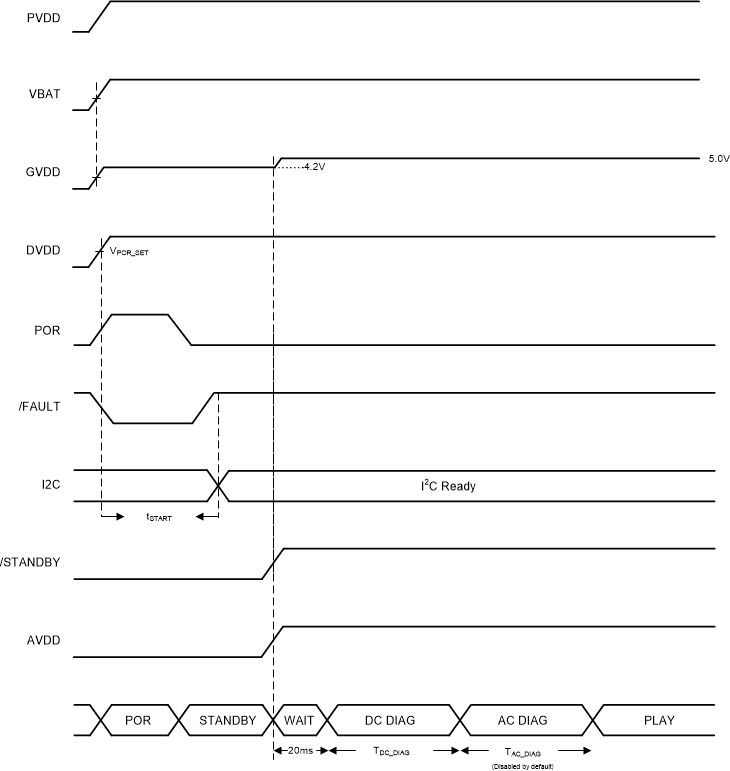SLASEP6B September 2019 – December 2020 TPA6304-Q1
PRODUCTION DATA
- 1 Features
- 2 Applications
- 3 Description
- 4 Revision History
- 5 Pin Configuration and Functions
- 6 Specifications
- 7 Parameter measurement information
-
7 Detailed Description
- 7.1 Overview
- 7.2 Functional Block Diagram
- 7.3
Feature Description
- 7.3.1 Single-Ended Analog Inputs
- 7.3.2 Gain Control
- 7.3.3 Class-D Operation and Spread Spectrum Control
- 7.3.4 Gate Drive
- 7.3.5 Power FETs
- 7.3.6
Load Diagnostics
- 7.3.6.1
DC Load Diagnostics
- 7.3.6.1.1 Automatic DC Load Diagnostics at Device Initialization
- 7.3.6.1.2 Automatic DC Load Diagnostics During Hi-Z to MUTE or PLAY Transition
- 7.3.6.1.3 Manual Start of DC Load Diagnostics
- 7.3.6.1.4 Short-to-Ground
- 7.3.6.1.5 Short-to-Power
- 7.3.6.1.6 Shorted Load and Open Load
- 7.3.6.1.7 Line Output Diagnostics
- 7.3.6.2 AC Load Diagnostics
- 7.3.6.1
DC Load Diagnostics
- 7.3.7 Power Supply
- 7.3.8 Device Initialization and Power-On-Reset (POR)
- 7.3.9 Protection and Monitoring
- 7.3.10 Hardware Control Pins
- 7.4
Device Functional Modes
- 7.4.1 Internal Reporting Signals
- 7.4.2 Device States and Flags
- 7.4.3 Fault Events
- 7.4.4 Warning Events
- 7.5 Programming
- 7.6 Register Maps
- 8 Application Information Disclaimer
- 9 Power Supply Recommendations
- 10Layout
- 11Device and Documentation Support
Package Options
Mechanical Data (Package|Pins)
- DDV|44
Thermal pad, mechanical data (Package|Pins)
- DDV|44
Orderable Information
7.3.8 Device Initialization and Power-On-Reset (POR)
When the system first powers up, or when the DVDD voltage momentarily drops below the POR threshold, the devices initializes.
During device initialization all I2C registers are be set to default values.
The FAULT Pin is activated and taken low.
The I2C device address is determined from the pull-up resistor on the FAULT pin. See I2C Address Selection for details.
Once the device finished initialization, the open drain FAULT pin is released.
Figure 7-4 shows the time from DVDD voltage crossing the POR threshold to release of the FAULT pin is approximately 10 ms.
After the initialization, bit 4 of the Power Fault Memory Register indicates that the device went through a POR cycle. Reading this I2C register clears the fault signaling bit.
 Figure 7-4 Typical Initialization Sequence and
Timing
Figure 7-4 Typical Initialization Sequence and
Timing